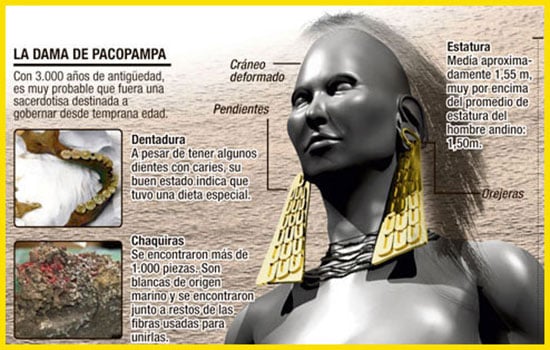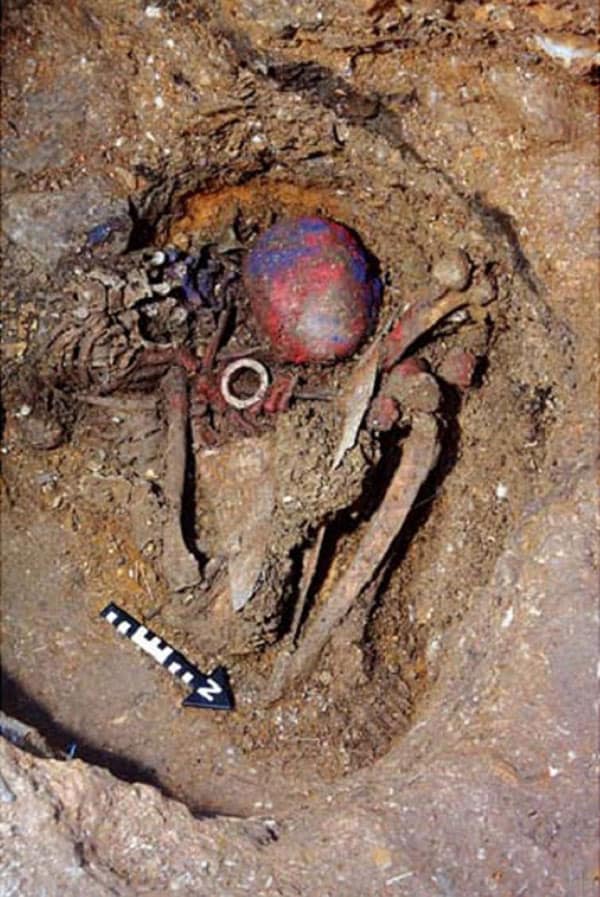A team of archaeologists from the Pacopampa Archaeological Project, led by renowned Japanese archaeologist Yuji Seki, uncovered a 6.8-foot-long tomb with 900-year-old remains in October 2009.
Pacopampa is an archaeological site in Peru’s northern highlands, 1 km from the same-named minor populated area in the district of Querocoto, in the province of Chota, in the department of Cajamarca.

This discovery was made in collaboration with archaeologists from California State University San Marcos and the Japanese archaeological mission led by Yuji Seki. An agreement between the National Museum of Ethnology in Osaka, Japan, and the National University of San Marcos, Peru, launched this archaeological project in 2005.
Human bones, ceramics, animal bones, minerals, metals, and stone artifacts were among the materials evaluated by the team, which included Japanese researchers and experts.
This 3,000year-old tomb belonged to a strong woman who was born on the highest terraces of Cerro San Pedro (today in the Cajamarca district of Chota), a fresh historical passage from a long time ago. Surprisingly, the settlement that occupied the site, known as the San Pedro de Pacopampa archaeological complex, celebrated the birth of a healthy girl who was destined to become a prominent leader.
When archaeologist Yuji Seki and his team uncovered this elite woman’s tomb in the Pacopampa Archaeological Complex, they also unearthed a crucial feature that gives new light on what life was like during the formative time (or Neo-Indian period).
The procedure of uncovering the funerary environment was extremely difficult for archaeologists. Yuji Seki spotted a very important element during those days of hard work that could corroborate a concept he first proposed five years ago when he was just starting his research in that region of Peru’s northern highlands. Physical anthropologists Kazuhiro Uzawa and Tomohito Nagaoka contributed their expertise to this study.
Seki revealed that the Lady of Pacopampa’s remains had a distortion in the rear of the head, as well as other unexplained materials, such as a blue substance (perhaps of mineral origin) placed over her remains with cinnabar, as was traditional at the time to bury the rulers of ancient Peru.
According to anthropologist Kazuhiro Uzawa, the Lady of Pacopampa’s cranial deformity could be the result of her guardians’ decision. Since her birth, splints have been placed on the back of her head to achieve this process of deforming her skull.

This process of cranial distortion began when she was three years old, according to a Japanese researcher. The findings of the Japanese anthropologists corroborated Yuji Seki’s hypothesis, which prompted him to conduct research into the evolution of political authority in ancient Peru.
The discovery of the Lady of Pacopampa’s remains provides new information and demonstrates the existence of privileged groups in the developing society of the time. Yuji Seki stated that his hypothesis was always present in his mind during the digs and that when the unexpected tomb of this ancient lady was revealed, it acted as confirmation of what he had always believed. The Japanese researcher is convinced that the young girl had a predetermined destiny that became a reality as she got older.
The presence of a unique rock in the middle of the main platform of the archaeological complex of San Pedro de Pacopampa was the first hint to the tomb’s existence.
Two gold earrings, each about 25 cm long, were worn by an ancient lady of considerable political or religious power. They were suspended from two earmuffs made of the same material as her earlobes. Other stone decorations and a necklace of mollusk shell beads were also discovered in her grave, indicating that Pacopampa had a commercial relationship with the coastal peoples at the time. The burial trousseau was completed by an anklet on the lady’s right foot.
A tiny bottle with a long neck, plain base, and globose body, a dessert dish with holes in its wooden platform base whereby the air enters to preserve combustion, a cup decorated with lines and circles, a bowl with a flat base that was found on the dessert dish and continues to remain of charcoal and ash that show the achievement of some ritual or ceremony moments before the burial were discovered alongside her remains.
One of the most significant finds of the Pacopampa Archaeological Project has been the remains of the “Lady of Pacopampa.” She was a young Andean woman, between the ages of 25 and 45. She stood at a height of 155 cm. Because the other burials unearthed in Cajamarca have an average height of 1.45m for women and 1.50m for males, scholars believe she was the tallest lady of her day. Her remains were buried on her left side and in a flexed position before the construction of the ceremonial temple, according to evidence.
Yuji Seki couldn’t say whether the Lady of Pacopampa was a queen, a chief, or a kind of counselor whose wisdom and power was based on the religious nature of their actions. He suggested she may be a powerful priestess who ruled the supernatural realm and had a firm grasp on ideas.
The use of gold, the squatting position of the corpses, and the crimson pigments that coat the remains, according to scholars, are all similarities to the lavish tombs discovered at Kuntur Wasi in Peru’s Andean highlands. The societal changes that happened in that region throughout the ninth century were substantiated by these commonalities.
There was, however, a significant difference between these two sites.
Pacopampa exhibits evidence of extensive usage of copper artifacts, which has not been found in other sites in the Cajamarca region. The experts established that there is a deposit of this mineral in that region that has been exploited for at least 3,000 years and that this could have been the power base of this ancient society’s governing classes.





